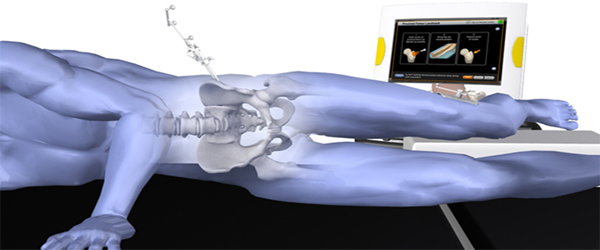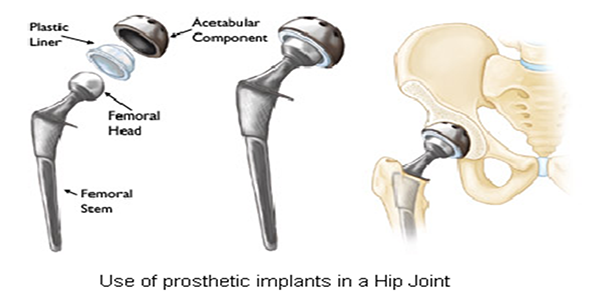Dr L Tomar has great expertise of performing Computer Assisted or Computer Navigated Minimally Invasive Hip Replacement Surgeries to improve implant placement, ligament balance and leg length control with the aim to achieve zero error complications related to implant, customizing with the the need of patient’s anatomy.
However, in a total hip replacement procedure without computer navigated support, joint replacement surgeon may have to deal with potential complications such as, angular misalignment or dislocation causing leg length discrepancy. Thanks to the recent advancements in the field of joint replacement with the introduction of most advanced minimally invasive total hip replacement surgery with the support of Computer Navigation System.

In computer navigation technology creates an image of the hip joint during the Hip Replacement Surgery & works by matching difference of reference points shown in the monitor of patient’s current or diseased hip with those of new hip. This immensely assist hip replacement surgeon to fine tune the adjustment of position of new hip with great certainty, almost eliminating error in implant placement. Therefore, hip replacement surgeon can check the articulation of hip replacement joint to function perfectly with the bones, muscle & ligaments.
With the support of Computer Navigation System, the minimal Invasive Hip Replacement Surgery is now very safe, reliable & precise. Using the information and images seen at computer of navigation system, the hip replacement surgeon always has more control during the operation of the operation & knows where to place the new hip. Also, now surgeon can precisely measure the leg difference during the operation, eliminating leg length difference issues faced by joint replacement surgeon so far now.
Advantages of Computer Navigated Minimal Invasive Hip Replacement Surgery
- More accurate alignment of the implanted joint that can enhance its overall movement and functioning joint
- Smaller incisions- Less pain and faster recovery
- Shorter hospital stay
- Minimal Scarring
- Less bleeding and need of blood transfusion
- Less disruption of tissue
- A longevity of implant greatly enhanced
- Minimizing the chance of dislocation after hip replacement
General Information about Hip Replacement Surgery in Delhi, India
What is Hip Replacement Surgery?
Hip Replacement or Hip Arthroplasty is an orthopaedic surgery in which hip joint is removed and replaced with an artificial (prosthetic) implant. The main purpose of the Hip Replacement surgery is to replace damaged hip joint and to treat severe pain which otherwise cannot be corrected with any other treatments.
Hip joint is one among the largest joints of the body. It is basically ball-and-socket joint, in which femur (thighbone) head has a ball like structure which fits into acetabulum which is a socket/cup like structure in pelvis (hip bone).
Type of Hip Replacement Surgeries
The Hip replacement surgery has broadly two types as-
Total Hip Replacement – Total Hip replacement surgery includes replacement of both -acetabulum (cup like structure of pelvis or hip bone) and femoral head (ball like structure). Damaged femoral head is changed with a prosthetic stem which consist a ball like structure on its head. This stem is placed into femur. In the same way damaged acetabulum is replaced with a prosthetic socket. Then the ball like structure of stem is inserted into new socket to form a new hip joint.
Half hip replacement (Hemiarthroplasty) – In this type of surgery only one part of the joint i.e. femoral head is replaced with a prosthetic implant (stem with ball on the top) and other part i.e. acetabulum is used as in its normal state.
It is important that after surgery the patient should undergo recommended physical therapy. Patient should do these exercises consistently as per the advice. These exercises strengthen the hips and help the patient to have proper movement for walking and other routine work.
Prevention after the surgery
After the hip replacement surgery a patient should take care of certain things for rest of his life so that life of replaced implanted joint can be increased.
- Patient should do regular light exercises for rest of his life, so that the joint movements remain good and light exercises also provide strength to the joint
- Patient should be careful and should avoid any fall or injury which may impact the hip joint.
- Before going for any dental procedure patient should inform the dentist about hip replacement. Antibiotics may be required.
- Patient should go to his surgeon for routine check-up of joint.
Some of the conditions in which Hip Replacement surgery may be needed are –
- Osteoarthritis – In Osteoarthritis joint cartilage gets damaged which causes pain and difficulty in moving. Cartilage is a kind of tissue which ensures proper movement of joint by reducing friction.
- Rheumatoid arthritis – In this condition synovial membrane of the joints get inflamed and thickened which also damages cartilage causing pain and stiffness in joints.
- Hip Injuries or diseases – Sometimes because of injury hip joints may be dislocated from their normal position and may sustain fracture. Some diseases also damage hip joints and cause pain.
- Congenital Reason – In some infants or in children there may be problem in hip joint. In some cases even after treatment it may emerge later in the life.
Dr L Tomar is doing both partial hip replacement surgery & total hip replacement surgery in Delhi, using Minimally invasive computer navigation technology. With more than 24 years of experience and expertise, Dr L. Tomar is one of the best hip replacement surgeons in Delhi and has successfully performed more than 3000 Hip Replacement Surgery. With the support of highly skilled and experienced medical team and latest technology, we offer best treatment and care to our patients.

